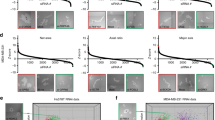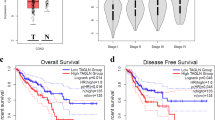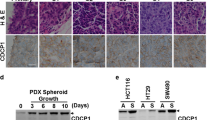Abstract
Here, we report unbiased screens for genes expressed in metastatic tumor cells that are associated with cell motility. These screens identified Ier2, an immediate early gene of unknown function, as potentially having a role in tumor cell motility and metastasis. Knockdown of Ier2 in 3T3 fibroblasts inhibited their motility upon relief of contact inhibition in monolayer wounding assays. Furthermore, ectopic Ier2 expression promoted the motility and invasiveness of poorly metastatic 1AS pancreatic tumor cells in vitro. Relief of contact inhibition was associated with translocation of the Ier2 protein from the cytoplasm to the nucleus in both 3T3 fibroblasts and 1AS tumor cells. Importantly, ectopic Ier2 expression in 1AS cells stimulated metastasis formation when cells were implanted into experimental animals. Furthermore, we found elevated Ier2 expression in a wide variety of human tumor types. This correlated with poor metastasis-free and overall survival in patients with colorectal adenocarcinomas. Together, these data reveal Ier2 as a new player in the regulation of tumor progression and metastasis, and suggest that Ier2 may be useful prognostically and therapeutically in the management of cancer.
This is a preview of subscription content, access via your institution
Access options
Subscribe to this journal
Receive 50 print issues and online access
$259.00 per year
only $5.18 per issue
Buy this article
- Purchase on Springer Link
- Instant access to full article PDF
Prices may be subject to local taxes which are calculated during checkout





Similar content being viewed by others
Accession codes
References
Aggarwal BB . (2004). Nuclear factor-kappaB: the enemy within. Cancer Cell 6: 203–208.
Baumann P, Cremers N, Kroese F, Orend G, Chiquet-Ehrismann R, Uede T et al. (2005). CD24 expression causes the acquisition of multiple cellular properties associated with tumor growth and metastasis. Cancer Res 65: 10783–10793.
Bradley LM . (2003). Migration and T-lymphocyte effector function. Curr Opin Immunol 15: 343–348.
Charles CH, Simske JS, O'Brien TP, Lau LF . (1990). Pip92: a short-lived, growth factor-inducible protein in BALB/c 3T3 and PC12 cells. Mol Cell Biol 10: 6769–6774.
Chen L, Ma S, Li B, Fink T, Zachar V, Takahashi M et al. (2003). Transcriptional activation of immediate-early gene ETR101 by human T-cell leukaemia virus type I Tax. J Gen Virol 84: 3203–3214.
Chiou CC, Chan CC, Sheu DL, Chen KT, Li YS, Chan EC . (2001). Helicobacter pylori infection induced alteration of gene expression in human gastric cells. Gut 48: 598–604.
Chung KC, Gomes I, Wang D, Lau LF, Rosner MR . (1998). Raf and fibroblast growth factor phosphorylate Elk1 and activate the serum response element of the immediate early gene pip92 by mitogen-activated protein kinase-independent as well as -dependent signaling pathways. Mol Cell Biol 18: 2272–2281.
Chung KC, Kim SM, Rhang S, Lau LF, Gomes I, Ahn YS . (2000a). Expression of immediate early gene pip92 during anisomycin-induced cell death is mediated by the JNK- and p38-dependent activation of Elk1. Eur J Biochem 267: 4676–4684.
Chung KC, Shin SW, Yoo M, Lee MY, Lee HW, Choe BK et al. (2000b). A systemic administration of NMDA induces immediate early gene pip92 in the hippocampus. J Neurochem 75: 9–17.
Coleclough C, Kuhn L, Lefkovits I . (1990). Regulation of mRNA abundance in activated T lymphocytes: identification of mRNA species affected by the inhibition of protein synthesis. Proc Natl Acad Sci USA 87: 1753–1757.
Eschelbach A, Hunziker A, Klimaschewski L . (1998). Differential display PCR reveals induction of immediate early genes by vasoactive intestinal peptide in PC12 cells. Ann N Y Acad Sci 865: 181–188.
Fambrough D, McClure K, Kazlauskas A, Lander ES . (1999). Diverse signaling pathways activated by growth factor receptors induce broadly overlapping, rather than independent, sets of genes. Cell 97: 727–741.
French PJ, Swagemakers SM, Nagel JH, Kouwenhoven MC, Brouwer E, van der Spek P et al. (2005). Gene expression profiles associated with treatment response in oligodendrogliomas. Cancer Res 65: 11335–11344.
Gutmann DH, Hedrick NM, Li J, Nagarajan R, Perry A, Watson MA . (2002). Comparative gene expression profile analysis of neurofibromatosis 1-associated and sporadic pilocytic astrocytomas. Cancer Res 62: 2085–2091.
Harlow E, Lane D . (1988). Antibodies: a Laboratory Manual. Cold Spring Harbor Press: Cold Spring Harbor.
Herrlich P, Zoller M, Pals ST, Ponta H . (1993). CD44 splice variants: metastases meet lymphocytes. Immunol Today 14: 395–399.
Hippo Y, Taniguchi H, Tsutsumi S, Machida N, Chong JM, Fukayama M et al. (2002). Global gene expression analysis of gastric cancer by oligonucleotide microarrays. Cancer Res 62: 233–240.
Hofmann M, Fieber C, Assmann V, Gottlicher M, Sleeman J, Plug R et al. (1998). Identification of IHABP, a 95 kDa intracellular hyaluronate binding protein. J Cell Sci 111 ( Pt 12): 1673–1684.
Hong SK, Dawid IB . (2009). FGF-dependent left-right asymmetry patterning in zebrafish is mediated by Ier2 and Fibp1. Proc Natl Acad Sci USA 106: 2230–2235.
Keeton AB, Amsler MO, Venable DY, Messina JL . (2002). Insulin signal transduction pathways and insulin-induced gene expression. J Biol Chem 277: 48565–48573.
Lau LF, Nathans D . (1985). Identification of a set of genes expressed during the G0/G1 transition of cultured mouse cells. EMBO J 4: 3145–3151.
Li W, Fan J, Chen M, Guan S, Sawcer D, Bokoch GM et al. (2004). Mechanism of human dermal fibroblast migration driven by type I collagen and platelet-derived growth factor-BB. Mol Biol Cell 15: 294–309.
Mengwasser J, Piau A, Schlag P, Sleeman JP . (2004). Differential immunization identifies PHB1/PHB2 as blood-borne tumor antigens. Oncogene 23: 7430–7435.
Milde-Langosch K . (2005). The Fos family of transcription factors and their role in tumourigenesis. Eur J Cancer 41: 2449–2461.
Nestl A, Von Stein OD, Zatloukal K, Thies WG, Herrlich P, Hofmann M et al. (2001). Gene expression patterns associated with the metastatic phenotype in rodent and human tumors. Cancer Res 61: 1569–1577.
Niebuhr K, Lingnau A, Frank R, Wehland J . (1998). Rapid procedures for preparing monoclonal antibodies and identifying their epitopes. In: Celis J (ed). Cell biology: a laboratory handbook, 2nd edn. Academic Press: San Diego, pp 398–403.
Rollins BJ, Stiles CD . (1989). Serum-inducible genes. Adv Cancer Res 53: 1–32.
Schneider A, Fischer A, Weber D, von Ahsen O, Scheek S, Kruger C et al. (2004). Restriction-mediated differential display (RMDD) identifies pip92 as a pro-apoptotic gene product induced during focal cerebral ischemia. J Cereb Blood Flow Metab 24: 224–236.
Scott JL, Dunn SM, Zeng T, Baker E, Sutherland GR, Burns GF . (1994). Phorbol ester-induced transcription of an immediate-early response gene by human T cells is inhibited by co-treatment with calcium ionophore. J Cell Biochem 54: 135–144.
Shimizu N, Ohta M, Fujiwara C, Sagara J, Mochizuki N, Oda T et al. (1991). Expression of a novel immediate early gene during 12-O-tetradecanoylphorbol-13-acetate-induced macrophagic differentiation of HL-60 cells. J Biol Chem 266: 12157–12161.
Skotheim RI, Lind GE, Monni O, Nesland JM, Abeler VM, Fossa SD et al. (2005). Differentiation of human embryonal carcinomas in vitro and in vivo reveals expression profiles relevant to normal development. Cancer Res 65: 5588–5598.
Sleeman JP, Nazarenko I, Thiele W . (2011). Do all roads lead to Rome? Routes to metastasis development. Int J Cancer 128: 2511–2526.
Smith DB, Johnson KS . (1988). Single-step purification of polypeptides expressed in Escherichia coli as fusions with glutathione S-transferase. Gene 67: 31–40.
Stein U, Jurchott K, Schlafke M, Hohenberger P . (2002). Expression of multidrug resistance genes MVP, MDR1, and MRP1 determined sequentially before, during, and after hyperthermic isolated limb perfusion of soft tissue sarcoma and melanoma patients. J Clin Oncol 20: 3282–3292.
Takaya T, Kasatani K, Noguchi S, Nikawa J . (2009). Functional analyses of immediate early gene ETR101 expressed in yeast. Biosci Biotechnol Biochem 73: 1653–1660.
Wallbaum S, Grau N, Schmid A, Frick K, Neeb A, Sleeman JP . (2009). Cell cycle quiescence can suppress transcription from an ecdysone receptor-based inducible promoter in mammalian cells. Biotechniques 46: 433–440.
Yu YP, Landsittel D, Jing L, Nelson J, Ren B, Liu L et al. (2004). Gene expression alterations in prostate cancer predicting tumor aggression and preceding development of malignancy. J Clin Oncol 22: 2790–2799.
Acknowledgements
We are very grateful to Norma Howells, Selma Huber and Manuela Sauer for their assistance with the animal experiments, to Anja Steffen for expert technical support and to Wilko Thiele for critical reading of this manuscript. The contribution of Franziska Arlt and Markus Niederstrasser is also gratefully acknowledged. This work was supported by grants to JPS and US from the BMBF NGFN2 CancerNet Programme and to JPS from the European Union (FP6 STREP project BRECOSM, contract no. LSHC-CT-2004-503224 and FP7 Collaborative Project TuMIC, contract no. HEALTH-F2-2008-201662).
Author information
Authors and Affiliations
Corresponding author
Ethics declarations
Competing interests
The authors declare no conflict of interest.
Additional information
Supplementary Information accompanies the paper on the Oncogene website
Rights and permissions
About this article
Cite this article
Neeb, A., Wallbaum, S., Novac, N. et al. The immediate early gene Ier2 promotes tumor cell motility and metastasis, and predicts poor survival of colorectal cancer patients. Oncogene 31, 3796–3806 (2012). https://doi.org/10.1038/onc.2011.535
Received:
Revised:
Accepted:
Published:
Issue Date:
DOI: https://doi.org/10.1038/onc.2011.535
Keywords
This article is cited by
-
CircRNF220, not its linear cognate gene RNF220, regulates cell growth and is associated with relapse in pediatric acute myeloid leukemia
Molecular Cancer (2021)
-
IER2-induced senescence drives melanoma invasion through osteopontin
Oncogene (2021)
-
Transcriptome meta-analysis reveals differences of immune profile between eutopic endometrium from stage I-II and III-IV endometriosis independently of hormonal milieu
Scientific Reports (2020)
-
Tracking Cancer Genetic Evolution using OncoTrack
Scientific Reports (2016)
-
The hypusine cascade promotes cancer progression and metastasis through the regulation of RhoA in squamous cell carcinoma
Oncogene (2016)



